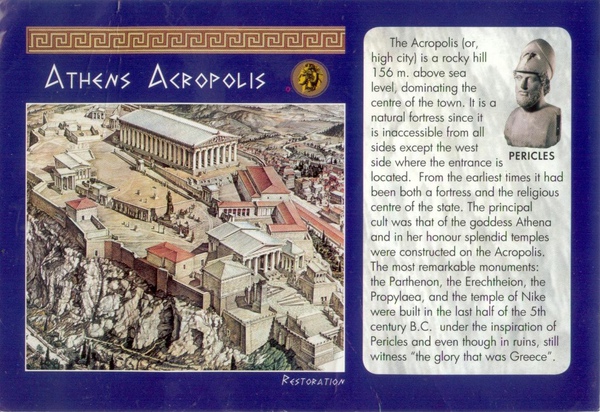 |
| An example of a modern postcard from Athens, Greece |
A rough draft of this annotated bibliography is due at the end of this class period. 15 points, based on half the rubric's score.
Don't forget -- you have a quiz tomorrow over your notes on Ancient Greece and the 30 European countries I listed earlier on this blog. Play the map game tonight!
The purpose of an Annotated Bibliography is to help you figure out whether or not you are using the best sources available for your project. You will use this method at PSM, at college, and even in the real world.
You can find the rubric for your annotated bibliography here. It is a 30 point project grade.
We will use MLA format for our Annotated Bibliography. You can find more information on how exactly to cite sources from the Purdue University OWL website. We will use MLA style to cite your sources.
An example of how each entry in your annotated bibliography should look is below:
Citation: Aristotle. Poetics. Trans. S. H. Butcher. The Internet Classics Archive. Web Atomic and Massachusetts Institute of Technology, 13 Sept. 2007. Web. 4 Nov. 2008. ‹http://classics.mit.edu/›.
Summary: This reading from Aristotle summarizes the Greek philosopher's ideas on poetry. It is a primary source. Aristotle tells the reader what purpose poetry serves, why it is important to the world, and why he enjoys it personally. The author's goal is to make sure that his readers understand the true worth of poets and poetry. The reading also gives an excellent example of Greek thought in the era around Alexander the Great's conquest of Asia.
Evaluation: Because it is a primary source, this document is very useful to me. I am able to use it to explain the way some Greeks looked at the world, and can compare this to the modern world. I would recommend that other people writing papers on Greek philosophy use this source because Aristotle is very easy to understand.
Getting Started
Remember -- your goal for this project is to do one of the following:
- Compare and contrast one topic from Ancient Greece with the same topic in the modern world (i.e., Ancient Greek and Modern Chicago architecture)
- Explain the influence of one topic from Ancient Greece on the same topic in the modern world (i.e., Ancient Greek food's influence on food in Modern Chicago)
You have to cite two research sources for your project -- one for Ancient Greece, one for the Modern World. You already found one source -- the information from the British Museum you looked at on Tuesday! Follow the steps below to cite the source. In addition to your project grade, you will receive a 10 point homework grade for following the steps below correctly:
Basically, the citation should look like this:
Editor, author, or compiler name (if available). Name of Site. Name of institution/organization affiliated with the site (sponsor or publisher), date of resource creation (if available). Medium of publication. Date of access. Link.Let's break it down:
- Create a new Word document. Save it in the Y:\Ramin World Geography folder. Find your correct period and save the document in the "Annotated Bibliography" folder. Save the document as "Your Last Name - AB" (1 point)
- Put your heading in the document. The name of the assignment is "Ancient Greece Annotated Bibliography" (1 point)
- Begin citing your first source. First, record the author's name. For a website, unless an article has a specific author listed, use the name of the organization who produced the site. (1 point)
- Record the name of the page you are citing in italics. (1 point)
- Record the name of the institution/organization that sponsors the site. (1 point)
- Record the date of publication, if available. (1 point)
- Record the medium of the publication -- for a website, put Web. If the source were print, you would put Print. (1 point)
- Record the date you accessed the publication. (1 point)
- Record the link for your website (1 point).
- Check to make sure that you followed the format shown above correctly! (1 point)
Summary
Now it's time to summarize your first source. The summary should be approximately 3-4 good sentences in length. Use the questions below to help create your summary. Ask yourself:
- What was the main point/main idea/central theme of the source?
- What important information did you get from the source?
- What did you learn from the source?
- How will I use this source in my project?
Evaluation
Finally, you must evaluate your source. This should be approximately 3-4 good sentences in length. Use the questions below to help create your evaluation. Ask yourself:
- Why is this a good source?
- Why should I trust the author? What are his/her/its qualifications?
- Is this source as good as, better than, or worse than other sources I've used?
- Would I recommend this source to other people?
Congratulations! You've completed the first entry on your annotated bibliography. You've got your ancient Greek source ready to go. Now it's time to find a modern source.
Remember -- you must find a source about a similar topic in the modern world. If you researched Greek art, you must find an example of modern art!
Here are some sources you could use:
- Lonely Planet, a travel guide website
- CultureGrams
- National Geographic
- The City of Chicago website
- The official Chicago Tourism website
- Chicago Magazine
- The Official U.S. Army website
- The Official U.S. Army recruiting website
- A site on Religion from CultureGrams
If you have a topic in mind that is not covered by these sites, talk to me! I can always help you find something new.
Once you've found your source, complete the same steps you followed for your ancient source to include it in your annotated bibliography.
No comments:
Post a Comment